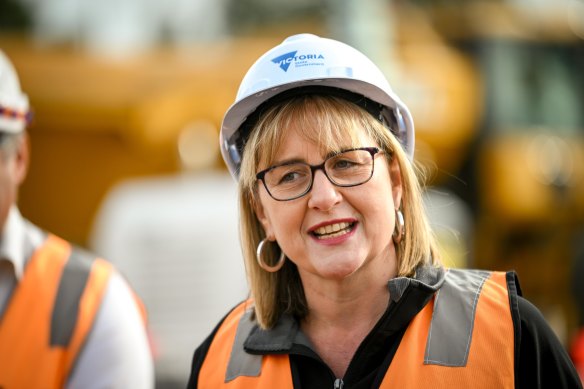By Kieran Rooney and Annika Smethurst
Victorian manufacturers, schools and hospitals will be able to buy renewable energy directly from the Allan government under plans for the State Electricity Commission to sell both retail and wholesale power.
Premier Jacinta Allan will on Thursday unveil a 10-year strategic plan for the SEC, including details of how the body will emerge as a player in the energy market through renewable projects across the state.

Premier Jacinta Allan.Credit: Eddie Jim
The SEC, revived as a key election pledge, will be responsible for the electricity generated from more than a dozen solar, wind and battery projects locked into long-term deals with the state.
Since 2017, the Victorian government has struck deals with these generators to buy a certain portion of their electricity, providing financial certainty to allow them to begin construction.
These contracts amount to 1.2 gigawatts of energy being added to the National Electricity Market and sold on to customers by the SEC. Later this year the commission is expected to announce $1 billion in funding to support new projects replacing 4.5 gigawatts of ageing coal-fired power, which could fall under similar arrangements.
Documents have been lodged and certified with the Australian Securities and Investment Commission to register the SEC as a business.
Allan will on Thursday reveal that government schools, hospitals and services housed in standalone buildings would be among its first customers. This would be followed by heavy industrial users such as manufacturers who purchase large amounts of energy under contract.
By 2025, the SEC would be expected to be servicing all government electricity requirements. It is not currently being set up as a business that can sell power to private households.
The intervention in the private sector is a wider role for SEC than first canvassed when it was first announced.
Throughout the 2022 election campaign, Labor promised the revived SEC would bring down power bills for customers, but did not specify how it could influence how private retailers set prices for households.
Then-premier Daniel Andrews instead outlined that the state would have a controlling share in new renewable energy projects, with profits reinvested into more projects to increase supply and lower the cost of wholesale electricity. He also flagged superannuation funds as a preferred investor.
However, the decision to set the SEC up as a business, selling to government clients and industrial customers, represents a significant expansion of this proposal. It means a state-owned business will be competing with companies to sell power to customers.
The Age first revealed in February the government was considering a wider role for the SEC, including selling power to homes or business.
At the time, director of Victoria University’s energy policy centre Bruce Mountain said it would have to be involved in retail if it wanted to lower prices.
“One of the big promises was lower prices for customers and simply selling your production on the wholesale market is no guarantee customers will get the gains of that,” he said in February.
State Electricity Commission Minister Lily D’Ambrosio said the retail plan would help free Victoria from its reliance on expensive fossil fuels and accelerate investment towards the state’s target of 95 per cent renewable energy generation by 2035.
“The SEC will announce its pioneer investment shortly, having received more than 100 registrations of interest from the private sector with 24 gigawatts of renewable energy generation and 30 gigawatts of storage projects across the state,” she said.
Energy experts have previously questioned the benefits of the SEC, with Grattan Institute energy director Tony Wood saying in June the government had made some “big statements” about its ability to provide more renewable energy and push down power prices.
“I can’t see anything that says the SEC is going to do something that the private sector wouldn’t have done,” he said.
In February, Alison Reeve, deputy director of the energy and climate program at the Grattan Institute, said she struggled to see what the advantage would be for consumers if the government became a direct retailer.
“I’m struggling to see what market failure it is addressing,” she said at the time. “If Labor is building 4.5 gigawatts of capacity, it’s still a very small player compared to the large generators like AGL and Origin.”
Almost all the projects used to secure the SEC’s 1.2 gigawatts in energy for the market have come from the Victorian Energy Renewable Target auction scheme, a program designed to bring forward investment and help the state meet its emissions goals.
Starting in 2017, the “reverse auction” process asked private companies to put in bids to the government to enter into 10- or 15-year support agreements where the state provided certainty by agreeing to buy a share of their energy generation.
Some arrangements also included a promise the government would pay the difference if the cost of power dipped below an agreed price.
The largest of these projects include the 336-megawatt Dundonnell Wind Farm, north-east of Warrnambool in Victoria’s south-west and the Kiamal Solar Farm, an hour south of Mildura, which has 150 megawatts of power and 300 megawatt hours of storage.
The original SEC was sold off by the Kennett government as part of a sweeping privatisation program in the 1990s.
Ahead of the 2022 election campaign, internal Labor polling showed electricity costs were a key issue for Victorians and there was support for government-owned energy. Andrews announced the SEC would be revived if his government was re-elected and regularly attacked the privatisation of the energy sector.
The original proposal for the commission was to invest taxpayer resources into enough renewable energy to offset the capacity of Loy Yang A power station, 4.5 gigawatts, ahead of its closure in 2035.
Get the day’s breaking news, entertainment ideas and a long read to enjoy. Sign up to receive our Evening Edition newsletter here.